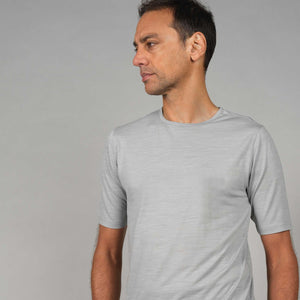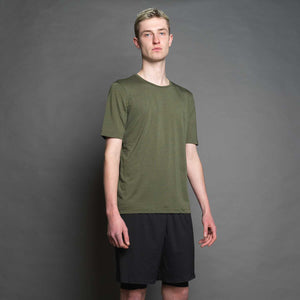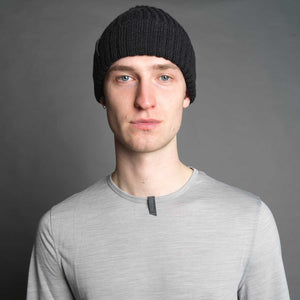Lycra is a good choice for making shorts. Good enough to have become ubiquitous. Yet the fabric we use is dramatically different from that employed by our competitors. Allowing us to create clothing with drastically different properties, it’s why each one of our products always begins with a search for the perfect material.

Ignore what’s gone before
Early in the development of our Signature Bib Shorts we realised the materials already on the market didn’t quite measure up. The standard recipe for most athletic clothing involves knitting together a quantity of affordable polyester or nylon with a smaller amount of more expensive elastane. Stretchy and comfortable, the resulting material is a cheap and easy option for clothing makers, who can purchase it in bulk and apply it across their ranges.
Little different from what you’ll find in a swimsuit or pair of tights, when applied to cycling this kind of material provides little inherent wind or water resistance. At the same time, the stretchy knit of its fibres easily comes apart under pressure, further diminishing its insulating properties while also reducing its opacity.
To form it into something usable on the bike, this means conventional Lycra materials require buttressing with all kinds of mechanical and chemical trickery. Happily, for most brands, a competent copywriter will be able to transform these workarounds into features on which the product can then be sold.

Look at the basics
An epic backstory won’t improve the quality of your next item of cycling gear. ashmei began as a design consultancy sourcing and developing performance clothing, which means we have an intrinsic understanding of material technology. Easily as useful, this lets us get stuck into the design process far earlier than our rivals.
Ideas still come to us while out riding. However, having identified the need for a product, rather than sketching a design and chasing the components to make it work, we’ll instead begin by addressing the problem at the level of the material.

Start at the beginning
The fabric used on our Signature Bib Shorts is a perfect example of this design philosophy. We started with a list of qualities needed from the finished product; a compressive fit, wind and water resistance, breathability, high opacity, and a minimum of superfluous detail. Yet none of these are properties naturally associated with the materials commonly used to make bib shorts.
In creating something better, one of the first things we went after was a much higher elastane content. Elastane imparts the qualities most of us look for in our shorts. Increasing the price of the material, upping its percentage nevertheless allowed us to drastically improve the compression offered by our shorts. Having the dual benefit of enhancing the support enjoyed by your muscles, its structure also means they don’t need to be clamped in place with restrictive cuffs.
Simultaneously more breathable, less inclined to hold water, and allowing for greater freedom of movement, a higher than average elastane content got us some way to achieving what we wanted from our shorts – changing the way the material itself is put together got us further still.

Putting it together
Most fabrics are knitted. Ours is woven. This allows us to do several clever things. First, it means we can control exactly its thickness to provide for better wind and water resistance. It also lets us avoid the pitfalls common to all knitted fabrics, chiefly their tendency to lose opacity as they stretch. Occurring as the fibres are pulled apart under stress, this can be uncomfortable when it lets the weather through, but is even more uncomfortable when it reveals more of what’s underneath than you’d have liked.
Knitted fabrics will also unravel if left unhemmed. Which doesn’t matter much as they’ll likely need further elasticated cuffs and facings to stay in place anyway.
By comparison, our fabric is structured enough to remain where we want it. This makes it doubly neat that its woven pattern also allows it to be laser cut to provide a flush, cuffless finish to our shorts.
Meaning we can reduce unnecessary components, this both creates a flattering silhouette while minimising the odds of any aspect irritating the rider. At the same time, this simpler construction also reduces the possibility of any individual part failing and so compromising the entire garment.
Letting the qualities of our products spring from the most basic unit of their construction is almost the exact opposite of how most companies create theirs. Talking about weaving and fibres is also not traditionally the stuff of marketing gold. But then we’d rather create great shorts rather than incredible stories.
---



